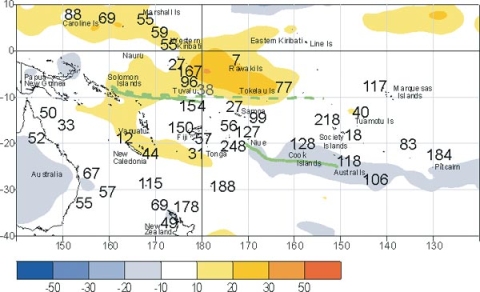Climate developments in August 2003
Extremely dry in New Caledonia and Vanuatu
A large area of suppressed convection occurred from the Solomon Islands southward to include Vanuatu and New Caledonia, and eastward to encompass Western Kiribati, Rawaki, and Tokelau. Many sites in these areas recorded less than 25% of their normal August rainfall, especially Vanuatu and northern areas of New Caledonia where it was extremely dry and some gauges recorded totals below 10 mm. Rainfall was also well below normal in Western Samoa, and below normal in the Caroline and Marshall Islands.
Although the South Pacific Convergence Zone (SPCZ) was near its average location west of the Date Line, it was less active than usual there. It was more active and much further south than usual in the east from southern Tonga to southern French Polynesia, with enhanced convection and rainfall at least 100% of normal over that region, including Niue and the southern Cook Islands. Rainfall was at least 200% of normal in parts of southern Tonga. Rainfall was also well above normal in Pitcairn, and isolated areas in Fiji’s Western Division. So far, the 2003 dry season (April-August) has been particularly dry over much of Kiribati, where rainfall has been 50% or less of normal.
Frequent southerly airflow kept air temperatures well below average in parts of Fiji and New Caledonia. In contrast, well above average mean air temperatures occurred in the Society Islands of French Polynesia.
Tarawa, Western Kiribati recorded its lowest frequency of easterlies (64% of observations) since January this year, and highest frequency of calms (30%) since May 2002.
Climate extremes in August 2003
| Country | Location | Rainfall (mm) | % of normal | Comments |
|---|---|---|---|---|
| New Caledonia | Koumac | 5 | 12 | Extremely low |
| Fiji | Labasa Airport | 5 | 11 | Extremely low |
| Fiji | Matei Airport | 8 | 6 | Extremely low |
| Eastern Kiribati | Kanton Island | 6 | 7 | Extremely low |
| French Polynesia | Tahiti-Faaa | 8 | 18 | Well below normal |
| Tonga | Nuku’alofa | 265 | 248 | Well above normal |
| Country | Location | Mean Air Temp (°C) | Dep. from Av | Comments |
|---|---|---|---|---|
| New Caledonia | La Roche | 17.4 | -1.0 | Well below average |
| New Caledonia | Ouanaham | 17.9 | -1.6 | Extremely low |
| Fiji | Nacocolevu | 21.6 | -1.1 | Extremely low |
| Fiji | Nadi | 22.4 | -1.3 | Extremely low |
| Fiji | Nausori | 21.8 | -1.1 | Extremely low |
| Fiji | Penang Mill | 22.4 | -1.7 | Extremely low |
| French Polynesia | Rapa Island | 19.3 | +1.3 | Extremely high |
| French Polynesia | Tahiti-Faaa | 25.9 | +1.1 | Extremely high |

